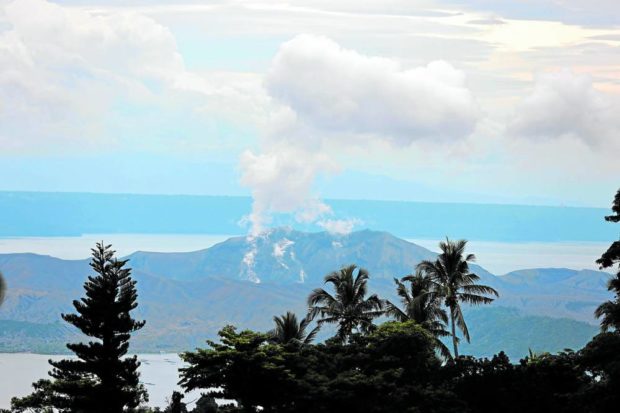
STEAM ACTIVITY Taal Volcano is showing signs of renewed unrest, with sulfur dioxide emission reaching over 17,000 metric tons on Sunday and voluminous steam-rich plume activity in the past three days, as shown in this photo taken on Monday. Residents in areas surrounding the volcano are asked to stay alert even as the volcano remains under alert level 1. —GRIG C. MONTEGRANDE
MANILA, Philippines — A total of 13,572 tons of volcanic sulfur dioxide was emitted from the main crater of Taal Volcano in Batangas, causing volcanic smog or “vog” over the Taal Caldera, the Philippine Institute of Volcanology and Seismology (Phivolcs) said Friday.
Phivolcs director and Department of Science and Technology Undersecretary Renato Solidum noted that the vog thickened from 9 a.m. to 2 p.m. of Thursday.
“Vog over the Taal Caldera yesterday was observed to thicken between 9:00 AM to 2:00 PM, while sulfurous stench was reported by residents of Banyaga, Agoncillo; Poblacion 5, Boso-boso, and Gulod, Laurel; and Poblacion, Talisay, Batangas,” he told INQUIRER.net in a message on Friday.
A caldera is defined as a cauldron-like hallow that forms after a volcanic eruption.
Aside from sulfur dioxide flux, degassing activity has likewise intensified, according to Solidum.
“SO2 flux since 15 July 2022 has averaged 7,818 tons/day, an increase from the average of 1,289 tons/day between May and mid-July 2022,” he said.
“Since the beginning of August 2022, there has been increased degassing activity in the form of visible upwelling of volcanic fluids in the Main Crater Lake and emission of voluminous steam-rich plumes that last night rose 2,800 meters above [the Taal Volcano Island],” the undersecretary continued.
With these developments, Solidum advised affected residents to limit their exposure and protect themselves as “vog consists of fine droplets containing volcanic gas” that may irritate eyes, throat, and respiratory tract.
“Avoid outdoor activities, stay indoors, and shut doors and windows to block out vog,” he urged.
“Cover your nose, ideally with an N95 face mask. Drink plenty of water to reduce any throat irritation or constriction,” he went on.
Individuals with health conditions, the elderly, pregnant women, and children may be particularly sensitive to vog, said Solidum.
He encouraged these groups of people to seek medical attention if necessary, “especially if serious effects are experienced.”
READ: Taal still showing signs of unrest

